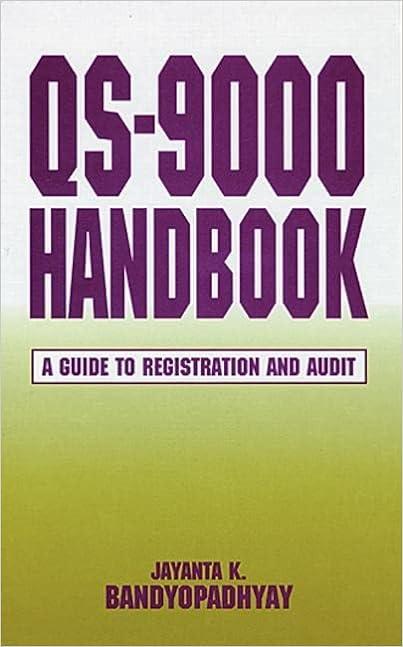Question
WoolCo buys sheeps wool from farmers. The company began operations in January of this year, and is making decisions on product offerings, pricing, and vendors.
WoolCo buys sheeps wool from farmers. The company began operations in January of this year, and is making decisions on product offerings, pricing, and vendors. The company is also examining its method of assigning overhead to products. Youve just been hired as a production manager at WoolCo.
Currently WoolCo makes three products: (1) raw, clean wool to be used as stuffing or insulation; (2) wool yarn for use in the textile industry, and (3) extra-thick yarn for use in rugs.
The company would like you to evaluate its costing methods for its raw wool and wool yarn. Upper management would also like your recommendations regarding a production decision regarding their current and proposed product lines.
Traditional costing allocates overhead costs to products based upon a predetermined factory overhead rate, which is computed using an estimated activity base such as direct labor hours or machine hours. The rate is computed as follows:
Predetermined Factory Overhead Rate = (Estimated Total Factory Overhead Costs) (Estimated Activity Base)
WoolCo has been using traditional costing with combing machine hours as the activity base. The company would like to consider activity-based costing
A cost allocation method that identifies activities causing the incurrence of costs and allocates these costs to products (or other cost objects), based on activity drivers (bases).
. In order to understand their current system better, you evaluate WoolCos current method of costing for raw wool and wool yarn. The production staff has compiled the following information for you on the production of 500 pounds of either raw wool or wool yarn:
| Total Factory | Total Costs |
| Overhead Costs | |
| Sorting | $25,600 |
| Cleaning | 38,400 |
| You are in Column Total Factory Overhead CostsCombing | You are in Column Total Costs1,300 |
| Raw Wool | Wool Yarn | |
| Hours of combing machine use required | You are in Column Raw Wool80 | You are in Column Wool Yarn20 |
In the following table, use combing machine hours as the activity base for assigning overhead costs to each product. When required, round your answers to the nearest dollar.
Predetermined factory overhead rate: per direct labor hour
Points:
| Raw Wool | Wool Yarn | ||||||||||||||||||||||||||||||||||||||||||||||||||||||||||||||||||||||||||||||||||||||||||||||||||
| Allocated factory overhead cost | You are in Column Raw Wool |
In order to compare WoolCos current traditional method with activity-based costing, you interview the production staff and compile the following information, which relates only to the costs for raw wool and wool yarn. WoolCo wishes to consider costing only for these two products at this time, since they are more established and have more data to evaluate.
In the following table, compute and enter the activity rate The estimated activity cost divided by estimated activity-base usage. for each of the three activities The types of work, or actions, involved in a manufacturing process or service activity. . If required, round your answers to the nearest cent.
Points: In the following table, allocate the costs of sorting, cleaning, and combing based on the rates of activity consumed by each products process. When required, round your answers to the nearest dollar.
Answer the following questions (1) and (2), then fill in table (3). 1. After reviewing your work on the Traditional Costing and Activity-Based Costing panels, which costing method would you recommend to WoolCo, and why? Activity-based costing, because it recognizes differences in how each product uses factory overhead activities, yielding more accurate product costs. Traditional costing, because it is a tried-and-true method used for the entire life of the company. The company should use whichever method is the cheapest to implement. Since both the methods give the same costs for each product, there is no advantage to either method. Points: Feedback Check My Work Explanation 2. After reviewing your work on the Continue/Discontinue panel, should WoolCo continue (Alternative 1) or discontinue (Alternative 2) the rug yarn product line? Discontinue (Alternative 2) Continue (Alternative 1) The company is indifferent between Alternative 1 and Alternative 2 Points: Feedback Check My Work Explanation 3. The following table shows several business decisions that might need to be made across the top row. Along the left-hand column, there are important factors to consider. Choose the factor(s) that are important to the decision. Check all that apply. If the factor is not important to any of the decisions, check the Not Important box.
|
Step by Step Solution
There are 3 Steps involved in it
Step: 1

Get Instant Access to Expert-Tailored Solutions
See step-by-step solutions with expert insights and AI powered tools for academic success
Step: 2

Step: 3

Ace Your Homework with AI
Get the answers you need in no time with our AI-driven, step-by-step assistance
Get Started


